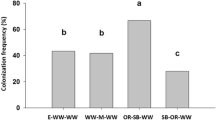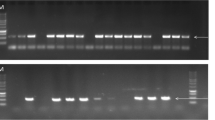Abstract
Fusarium head blight (FHB) is an important disease throughout many of the world wheat-growing areas that have humid to semi-humid climate. The infection happens mainly during the anthesis of the wheat, when there have been favorable conditions of moisture and temperature. The direct relation of the infection to environmental factors makes possible the formulation of mathematical models that predict the disease. The causal agent of the FHB of the spike of wheat is attributed principally to Fusarium graminearum. High economic losses due yield decrease have been recorded in Argentina. In the present work, 67 isolates of Fusarium spp. were obtained from samples of wheat grains from Pampas region from 15 locations distributed in Buenos Aires, Entre Ríos, Santa Fe and Córboba provinces during 2006 and 2007 wheat-growing seasons. The identification of species from monosporic isolates was carried out by morphological characterization and use of species-specific PCR-based assays. Both identification criteria were necessary and complementary for the species determination, since in some cases the molecular identification was not specific. Scanty presence of F. graminearum was observed in 2006 wheat-growing season coinciding with the lack of favorable meteorological conditions for producing FHB infection events. High presence of F. graminearum isolates was observed in 2007 wheat-growing season, in accordance with moderate incidence of the disease according to spatial distribution of FHB incidence values. The aim of this report was to identify the causal agent of the FHB disease by different taxonomic criteria and to relate its occurrence with disease incidence values predicted by a weather-based model in Argentina.




Similar content being viewed by others
Abbreviations
- INTA:
-
Instituto Nacional de Tecnología Agropecuaria
- SENASA:
-
Servicio Nacional de Sanidad y Calidad Agropecuaria
References
Monds RD, Cromey MG, Lauren DR, di Menna M, Marshall J. Fusarium graminearum, F. cortaderieae and F. pseudograminearum in New Zealand: molecular phylogenetic analysis, mycotoxin chemotypes and co-existence of species. Mycol Res. 2005;109(4):410–20.
Bai G-H, Shaner G. Scab of wheat: prospects for control. Plant Dis. 1994;78:760–6.
Bai G-H, Desjardins AE, Plattner RD. Deoxynivalenol-nonproducing Fusarium graminearum causes initial infection, but does not cause disease spread in wheat spikes. Mycopathologia. 2001;153:91–8.
Galich AN, de Galich MTV. Enfermedades de trigo en el área central norte de la región cerealera Argentina. Infome Técnico 121. E.E.A INTA Marcos Juárez, Córdoba, Argentina. 1996 (in Spanish).
Dyer RB, Kendra DF, Brown DW. Real-time PCR assay to quantify Fusarium graminearum wild-type and recombinant mutant DNA in plant material. J Microbiol Methods. 2006;67:534–42.
Osborne LE, Stein JM. Epidemiology of Fusarium head blight on small-grain cereals. Int J Food Microbiol. 2007;119(1–2):103–8.
McMullem M, Jones R, Gallenberg D. Scab of wheat and barley: a re-emerging disease of devasting impact. Plant Dis. 1997;81(12):1340–8.
Windels C. Economical and social impacts of Fusarium Head Blight changing farms and rural communities in the northern great plains. Phytopathology. 2000;90:17–21.
Galich MT. Fusarium head blight in Argentina. In: Duvin HJ, Gilchrist R, Reeves J, McNab A, editors. Fusarium Head Scab: global status and future prospects. México: Centro Internacional de Mejoramiento de Maíz y Trigo; 1997. p. 19–28.
Galich MT. Importancia y difusión de la Fusariosis de trigo en Argentina. In: Kohli MM, editors (Ed CIMMYT). International Maize and Wheat Improvement Center; 1989. p. 7–31 (in Spanish).
Zeller K, Bowden R, Leslie J. Diversity of epidemic populations of Gibberella zeae from small quadrats in Kansas and North Dakota. Phytopthology. 2003;93:874–80.
Schaafsma AW, Hooker DC. Climatic models to predict occurrence of Fusarium toxins in wheat and maize. Int J Food Microbiol. 2007;119:116–25.
Prandini A, Sigolo S, Filippi L, Battilani P, Piva G. Review of predictive models for Fusarium head blight and related mycotoxin contamination in wheat. Food Chem Toxicol. 2009;47:927–31.
Moschini RC, Fortugno C. Predicting wheat head blight incidence using models based on meteorological factors in Pergamino, Argentina. Eur J Plant Pathol. 1996;102:211–8.
Moschini RC, Pioli R, Carmona M, Sacchi O. Empirical predictions of wheat head blight in the northern Argentinean pampas region. Crop Sci. 2001;41:1541–5.
Carranza M, Moschini RC, Kraan G, Bariffi JH. Examination of meteorology-based predictions of Fusarium head blight of wheat grown at two locations in the southern Pampas region of Argentina. Aust Plant Pathol. 2007;36:1–4.
Moschini RC, Bischoff S. Meteorological-based systems for predicting and managing Fusarium Head Blight epidemics in the wheat growing area of Argentina. In: Proceedings of the 5th Canadian workshop on Fusarium Head Blight 2007. Winnipeg, Canada, November 27th–30th, p. 88–95.
Parry DW, Pettitt TR, Jenkinson P, Lees AK. The cereal Fusarim complex. In: Blakerman P, Williamson B, editors. Ecology of plant pathogens. Wallingford: CAB International; 1994. p. 301–20.
Parry DW, McLeod L, Jenkinson P. Fusarium head blight (scab) in small grain cereal a review. Plant Pathol. 1995;4:207–38.
Neergaard P. Seed pathology. London: MacMillan; 1977.
Nelson PE, Dignani MC, Anaissie EJ. Taxonomy, biology and clinical aspects of Fusarium species. Clin Microbiol Rev. 1994;74(4):479–504.
Fisher NL, Burgess LW, Tousson TA, Nelson PE. Carnation leaves as a substrate and for preserving cultures of Fusarium species. Phytopathology. 1982;72:151–3.
Burgess LW, Summerell BA, Bullock S, Gott KP, Backhouuse D. Laboratory manual for Fusarium research. 3rd ed. Sydney: University of Sydney; 1994.
Gerlach W, Nirenberg H. The genus Fusarium—a pictorial atlas. Mitt Biol Bundesanst. Ld – u Forstw. Berlin- Dahlem 1982;209:1–406.
Leslie JF, Summerell BA. The Fusarium laboratory manual, 1st edn. Ames: Backwell, 2006;110 4:573–85.
Summerell BA, Salleh B, Leslie JF. A utilitarian approach to Fusarium identification. Plant Dis. 2003;87:117–28.
Murray MG, Thompson WF. Rapid isolation of high molecular weight plant DNA. Nucleic Acids Res. 1980;8:4321–5.
Nicholson P, Simpson DR, Weston G, Rezanoor HN, Lees AK, Parry DW, Joyce D. Detection and quantification of Fusarium culmorum and Fusarium graminearum in cereal using PCR assays. Physiol Mol Plant Pathol. 1998;53:17–37.
Parry DW, Nicholson P. Development of a PCR assay to detect Fusarium poae in wheat. Plant Pathol. 1996;45:383–91.
Williams KJ, Dennis JJ, Smyl C, Wallwork H. The application of species-specific assay based on the polymerase chain reaction to analyze Fusarium crown rot of durum wheat. Austr Plant Pathol. 2002;31:19–129.
Turner AS, Lees AK, Rezanoor HN, Nicholson P. Refinement of PCR-detection of Fusarium avenaceum and evidence from DNA marker studies for phenetic relatedness to Fusarium tricinctum. Plant Pathol. 1998;47:278–88.
Moschini RC, Bischoff S, Martínez MI. Variabilidad climática y ocurrencia de enfermedades: caso de estudio: Fusariosis de la espiga de trigo. Horizonte A. Magazine de las Ciencias Agrarias 2008. Año 5 N°21. Facultad de Agronomía de la Universidad de Buenos Aires, p. 10–5 (in Spanish).
Ramírez ML, Reynoso MM, Farnochi MC, Chulze S. Vegetative compatibility and mycotoxin chemotypes among Fusarium graminearum (Gibberella zeae) isolates from wheat in Argentina. Eur J Plant Pathol. 2006;115:139–48.
Lori GA. Género Fusarium en Argentina II. Identificación de cultivos en la zona de La Plata. Rev Arg Microbiol. 1985;17(2):61–7 (in Spanish).
Leslie JF, Anderson LL, Bowden RL, Lee Y-W. Inter- and intra-specific genetic variation in Fusarium. Int J Food Microbiol. 2007;119(1–2):25–32.
Schilling AG, Moller WM, Geiger HH. Polymerase chain reaction-based assays for species-specific detection of Fusarium culmorum, F. graminearum, and F. avenaceum. Phytopathology. 1996;85(5):515–22.
Demeke T, Clear RM, Patrick SK, Gaba D. Species-specific PCR-based assays for the detection of Fusarium species and a comparison with the whole seed agar plate method and trichothecene analysis. Int J Food Microbiol. 2005;103:271–84.
Doohan FM, Parry DW, Jenkinson P, Nicholson P. The use of species-specific PCR-based assays to analyze Fusarium head blight of wheat. Plant Pathol. 1998;4:109–205.
Akinsanmi OA, Backhouse D, Simpfendorfer S, Chakraborty S. Mycelial compatibility reactions of Australian Fusarium graminearum, F. pseudograminearum isolates compared with AFLP groupings. Plant Pathol. 2008;57:251–61.
Chung W-H, Ishii H, Nishimura K, Ohshima M, Iwama T, Yoshimatsu H. Genetic analysis and PCR-based identification of major Fusarium species causing head blight on wheat in Japan. J Genet Plant Pathol. 2008;74:364–74.
Yli-Mattila T, Paavanen-Huhtala S, Parikka R, Konstantinova P, Gagkaena TY. Molecular and morphological diversity of Fusarium species in Finland and north-western Russia. Eur J Plant Pathol. 2004;110:573–85.
Busso C, Nobuyoshi Kaneshima E, de Assis Franco F, Boto Querol C, Alves de Castro-Prado MA. Vegetative compatibility and molecular characterization of Fusarium graminearum isolates from the State of Paraná, Brazil. Ciencia Rural. 2007;37(6):2–6.
Gagkaeva TY, Yli-Mattila T. Genetic diversity of Fusarium graminearum in Europe and Asia. Eur J Plant Pathol. 2004;110:551–62.
Láday M, Juhász Á, Mulé G, Moretti A, Logrieco A. Mitochondrial DNA diversity and lineage determination of European isolates of Fusarium graminearum (Gibberella zeae). Eur J Plant Pathol. 2004;110:545–50.
de Galich MTV, Galich AN. Enfermedades del trigo en el área sur de Santa Fé y Córdoba. Información para extensión 5. Córdoba, Argentina: EEA-INTA Marcos Juárez; 1994 (in Spanish).
Bowden RL, Leslie JF. Diversity of Gibberella zeae (Fusarum graminearum) at small spatial scales. Phytopathology. 1994;84:1140 (Abstr.).
Gilbert J, Abramson D, McCallum S, Clear R. Comparison of Canadian Fusarium graminearum isolates for aggressiveness, vegetative compatibility, and production of ergosterol and mycotoxins. Mycopathologia. 2001;153:209–15.
MacCallum BD, Tekauz A, Gilbert J. Vegetative compatibility among Fusarium graminearum (Gibberella zeae) isolates from barley spikes in Southern Manitoba. Can J Plant Pathol. 2001;23:83–7.
Moon J-H, Lee Y-H, Lee Y-W. Vegetative compatibility groups in Fusarium graminearum isolates from corn and barley in Korea. Plant Pathol J. 1999;15:53–6.
Dalcero A, Torres A, Etcheverry M, Chulze S, Varsavsky E. Ocurrence of deoxynivalenol and Fusarium graminearum in Argentinean wheat. Food Addit Contam. 1997;14(1):11–4.
Lori GA, Sisterna MN, Haldukowski M, Rizzo I. Fusarium graminearum and deoxynivalenol contamination in the durum wheat area of Argentina. Microbiol Res. 2004;158(1):29–35.
Moschini RC, Carranza MR, Carmona M. Meteorological-based predictions of wheat head blight epidemic in the southern Argentinean pampas region. Cereal Res Commun. 2004;32:45–52.
Acknowledgments
We thank Universidad Nacional de La Plata (Grant 11/X417), INTA (Project AEPV 2552) and CONICET (Grant PIP 5931) for financial support and technical assistance of Bernardina Catalina López and Prof. Dr. S. Chulze (Universidad Nacional de Río Cuarto, Argentina) for their generous supply of the control fungi.
Author information
Authors and Affiliations
Corresponding author
Rights and permissions
About this article
Cite this article
Kikot, G.E., Moschini, R., Consolo, V.F. et al. Occurrence of Different Species of Fusarium from Wheat in Relation to Disease Levels Predicted by a Weather-Based Model in Argentina Pampas Region. Mycopathologia 171, 139–149 (2011). https://doi.org/10.1007/s11046-010-9335-0
Received:
Accepted:
Published:
Issue Date:
DOI: https://doi.org/10.1007/s11046-010-9335-0




